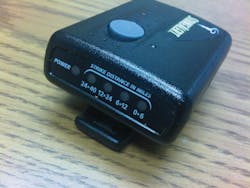Know When To Leave The Ramp Before Lightning Strikes
With the summer season upon us, the risk for severe weather is more probable as the temperatures steadily rise and thunderstorms become more frequent.
Summer thunderstorms and other severe weather conditions reduce the normal margin of safety in an outdoor operating environment and recovery to normal operations may take time after an event.
As a result, knowing when severe weather will hit your airport is a very important element to prevent employee injuries and GSE damage.
One major concern to ground service employees is the potential for cloud-to-ground lightning. Advancements in technology have provided airline employees with more robust lightning detection, as well as lightning prediction systems that work in conjunction with the use of weather service providers.
Lightning detection systems include cloud-to-cloud as well as cloud-to-ground lightning warnings. If there is a system installed at your airport, it is important to know exactly what your local system is reporting. Regardless of technology, however, anyone who sees lightning in the vicinity while out on the ramp in the operation should head inside until the weather passes.
Weather service information when combined with lightning prediction and detection systems will help in making safe, accurate decisions about ramp operations when severe weather approaches.
WEATHER WARNINGS
Most of us are familiar with one such provider. The National Weather Service will provide bulletins about severe weather. These bulletins should be monitored and all relative information communicated to ground employees to ensure safety prior to any weather event.
Another severe weather tool that can be accessed is the Airport Weather Warnings, a specialized bulletin available from the NWS in larger hub cities throughout the United States. The AWW can be set up and customized to the specific needs of an aircraft operating environment.
For more information, contact your local office of the National Oceanic and Atmospheric Administration (www.noaa.gov) or the National Weather Service (www.weather.gov).
Airport facilities across the United States have current detection/prediction systems that produce visual and aural alarms when severe weather (thunderstorms and lightning strikes) are approaching. When these alarms are triggered, the operational areas are then cleared of all ground employees; the return to the field notifications is also made using these systems.
Some airports use several different color lights:
- Green for "all clear."
- Yellow for "warning."
- Red for "take shelter."
Some experts, however, recommend using a blue, flashing light as best for single-light systems since it is less likely to be confused with other lights.
Horns or sirens may also be used, but must be able to be heard above the engine and equipment noise.
Automatic detection systems track storms, count and locate each lightning strike, and determine the potential for lightning strikes based on atmospheric conditions available. Many different systems are already in place in airports that are owned and maintained by either airline carriers or airport authorities.
When using a lightning detection/prediction system, the proximity of the severe weather is determined by a series of range rings on the station’s lightning display map. A minimum of three proximity rings is recommended.
However, if the system setting allows for four proximity rings, they should be set as follows:
- 15 miles.
- 8 miles.
- 5 miles
- 3 miles.
When a lightning bolt is indicated on the display of a lightning detection/prediction system, here are a few steps to remember when dealing with severe weather and lightning:
- At 15 miles: Local station leadership (or a designated ground operations employee) should begin monitoring storm activity and communicating alerts and ramp closures to all operating departments.
- At 8 miles: Ensure all airport operations employees have up-to-date information on the severe weather event. Local station leadership should be responsible for ensuring that a severe weather/lightning communications plan is implemented.
- At 5 miles: Be prepared to stop fueling operations.
- At 3 miles: Ground employees should discontinue aircraft communication with the communications headset.
Be prepared to stop all ramp activity and clear the ramp at 2 miles.
If the ramp is cleared due to severe weather ensure all ground employees are off the ramp and not seeking shelter under the aircraft, under any facility overhangs, near light poles or fences.
This procedural suggestions have proven effective over time. They can result in lesser amounts of damage when advance notification of approaching severe weather is provided or when a severe weather event occurs without warning. The implementation of lightning detection and prediction systems have been found to be effective when properly maintained.
NOTE: Some of these systems are prone to false positives and some predict lightning potential that may never materialize into actual strikes. This can cause airport employees to lose confidence in the warning system. These systems require human monitoring, human interpretation and continual system maintenance for more accurate atmospheric condition analysis. Systems that combine several methods of detection along with visual observation are the most effective.
NONTECH PROTECTION
There are also a couple of nontechnological approaches to severe weather prediction:
- The count method is based on the principle that sound travels at approximately one-fifth of a mile per second.
The approximate distance to the storm can be determined by counting the number of seconds between the flash of lightning and the sound of thunder. Divide the number of seconds by 5 to arrive at the approximate distance of the storm in miles.
- The 30/30 rule recommends that outdoor activities stop following a cloud-to-ground lightning strike within 6 statute miles (corresponding to 30 seconds of time delay between the visible lightning strike and the sound of thunder) and not be resumed until 30 minutes after the last lightning strike within 6 statute miles is observed.
Additional research conducted on this rule solely for airport use on economic and operational impact reduced the “all clear” time from 30 minutes to 15 minutes after the last reported lightning strike within 6 miles of the airport.
While this could represent an increased hazard for ramp personnel, it results in a significant reduction in delay time. Again, common sense and extreme caution should always be used when confronted with lightning and thunderstorm activity.
A combination of some or all of these methods is a best practice, and some experts consider quality local prediction systems as the single most effective tool.
Any information regarding storm activity obtained from one or more of the above methods should always be used in conjunction with information from local weather professionals. Common sense and extreme caution should always be used when confronted with lightning and thunderstorm activity.
No two events are identical, but a broad flexible plan should provide enough options and information to provide safety to the ground crews out in the operation when faced with severe weather.
About the author: Kevin P. Crowley, an analyst for ground safety programs, JetBlue Airways Corp., started on the ramp in Buffalo, NY, in 1993. He's been with JetBlue for 12 years and began as an instructor at JetBlue University and taught aircraft servicing for the A320 and E190. He has additional experience in HAZMAT and dangerous goods; winter ops and deicing; and is a certified OHSA instructor.
About the Author

Kevin Crowley
About the author: Kevin P. Crowley, senior analyst for ground safety programs, CQA/ASQ, JetBlue Airways Corp., started on the ramp in Buffalo, NY, in 1993. He's been with JetBlue for 12 years and began as an instructor at JetBlue University and taught aircraft servicing for the A320 and E190. He has additional experience in HAZMAT and dangerous goods; winter ops and deicing; and is a certified OHSA instructor.
